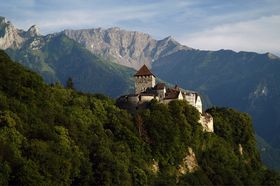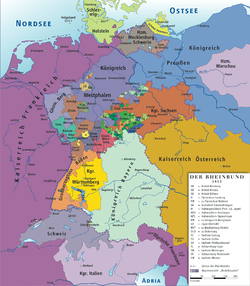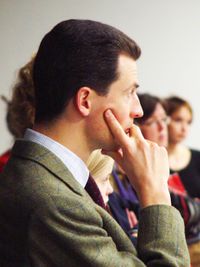تاريخ ليختنشتاين
Political identity came to the territory now occupied by the Principality of Liechtenstein in 814, with the formation of the subcountry of Lower Rhaetia.[1] Liechtenstein's borders have remained unchanged since 1434, when the Rhine established the border between the Holy Roman Empire and the Swiss cantons.
. . . . . . . . . . . . . . . . . . . . . . . . . . . . . . . . . . . . . . . . . . . . . . . . . . . . . . . . . . . . . . . . . . . . . . . . . . . . . . . . . . . . . . . . . . . . . . . . . . . . . . . . . . . . . . . . . . . . . . . . . . . . . . . . . . . . . . . . . . . . . . . . . . . . . . . . . . . . . . . . . . . . . . . .
العصور القديمة
A Roman road crossed the region from south to north, traversing the Alps by the Splügen Pass and following the right bank of the Rhine at the edge of the floodplain, for long uninhabited because of periodic flooding. Roman villas have been excavated in Schaanwald and Nendeln. The late Roman influx of the Alemanni from the north is memorialized by the remains of a Roman fort at Schaan.
العصور الوسطى

The area, part of Rhaetia, was incorporated into the Carolingian empire, and divided into countships, which became subdivided over the generations. Because the duchy of Swabia lost its duke in 1268 and was never restored, all vassals of the duchy became immediate vassals of the Imperial Throne (as has happened in much of Westphalia when the duchy of Saxons was divided and partially dissolved in aftermath of the defeat of Henry the Lion).
The medieval county of Vaduz was formed in 1342 as a small subdivision of the Werdenberg county of the dynasty of Montfort of Vorarlberg. The 15th century brought three wars and some devastation.
The Liechtenstein dynasty, from which the Principality takes its name (rather than vice-versa) from Castle Liechtenstein in faraway Lower Austria, which it owned from at least 1140 until the 13th century and from 1807 onwards. Over the centuries, it acquired vast swathes of land, mostly in Moravia, Lower Austria and Styria, but all these expansive and rich territories were held in fief under other more senior feudal lords, particularly under various lines of the Habsburg family, to which many Liechtensteins were close advisors. Thus, and without any territory held directly under the Imperial throne, the Liechtenstein dynasty was unable to meet a primary requirement to qualify for a seat in the Imperial diet, the Reichstag, although they were elevated to princely rank in late 17th century.
Early Modern Era
Liechtenstein was invaded by both Austrian and Swedish troops during the Thirty Years' War (1618–48).[1]
During the 17th century the country was afflicted by a plague and also by a witch hunt, in which more than 100 persons were persecuted and executed.
Prince Johann Adam Andreas of Liechtenstein bought the domain of Schellenberg in 1699 and the county of Vaduz in 1712. This Prince Liechtenstein had wide landholdings in Austria, Bohemia and Moravia, but none of the lands were held directly from the Emperor. Thus the prince was barred from admittance to the Council of Princes and the prestige and influence that would entail.
By acquiring these Lordships, which were directly subordinate to the Holy Empire because there was no duke of Swabia any longer, the Prince of Liechtenstein obtained his end by having this small patch of mountain villages. The territory took the name of the family that now ruled the county. On January 23, 1719, emperor Karl VI decreed that the counties of Vaduz and Schellenberg be promoted to a principality with the name Liechtenstein for his servant Anton Florian of Liechtenstein whereby they became Heiliger Römischer Reichsfürst.
القرن التاسع عشر
Liechtenstein became a sovereign state in 1806 when it joined Napoleon's Confederation of the Rhine upon the dissolution of the Holy Roman Empire.
The French under Napoleon occupied the country for a few years, but Liechtenstein retained its independence in 1815. Soon afterward, Liechtenstein joined the German Confederation (20 June 1815 – 24 August 1866, which was presided over by the Emperor of Austria).
Then, in 1818, Johann I granted a constitution, although it was limited in its nature. 1818 also saw the first visit of a member of the house of Liechtenstein, Prince Alois. However, the first visit by a sovereign prince would not occur until 1842.
In 1862, a new Constitution was promulgated, which provided for a Diet representative of the people. In 1868, after the German Confederation dissolved, Liechtenstein disbanded its army of 80 men and declared its permanent neutrality, which was respected during both World Wars.
ليختنشتاين أثناء الحروب العالمية
Until the end of الحرب العالمية الأولى, Liechtenstein was closely tied to Austria, but the economic devastation caused by that conflict forced the country to conclude a customs and monetary union with Switzerland. In 1919 Liechtenstein and Switzerland signed a treaty under which Switzerland assumes the representation of Liechtenstein interests at the diplomatic and consular level in countries where it maintains a representation and Liechtenstein does not.
In the spring of 1938, just after the annexation of Austria into Greater Germany, eighty-four year-old Prince Franz I abdicated, naming his thirty-one year-old third cousin, Prince Franz Joseph II, as his successor. While Prince Franz I claimed that old age was his reason for abdicating, it is believed that he had no desire to be on the throne if Germany gobbled up its new neighbor, Liechtenstein. His wife, whom he married in 1929, was a wealthy Jewish woman from Vienna, and local Liechtenstein Nazis had already singled her out as their anti-Semitic "problem". Although Liechtenstein had no official Nazi party, a Nazi sympathy movement had been simmering for years within its National Union party.[2]
Prince Franz Josef II became the first Prince of Liechtenstein to take up permanent residence in Liechtenstein.
During الحرب العالمية الثانية, Liechtenstein remained neutral, while family treasures within the war zone were brought to Liechtenstein (and لندن) for safekeeping. At the close of the conflict, Czechoslovakia and Poland, acting to seize what they considered to be German possessions, expropriated the entirety of the Liechtenstein dynasty's hereditary lands and possessions in Bohemia, Moravia, and Silesia — the princes of Liechtenstein lived in Vienna until the Anschluss of 1938. The expropriations (subject to modern legal dispute at the World Court) included over 1,600 square kilometres (600 mi.²) of agricultural and forest land, also including several family castles and palaces. Citizens of Liechtenstein were also forbidden from entering Czechoslovakia during the Cold War. Liechtenstein gave asylum to approximately five hundred soldiers of the First Russian National Army (a collaborationist Russian force within the German Wehrmacht) at the close of World War II; this is commemorated by a monument at the border town of Hinterschellenberg which is marked on the country's tourist map. The act of granting asylum was no small matter as the country was poor and had difficulty feeding and caring for such a large group of refugees. Eventually, Argentina agreed to permanently resettle the asylum seekers. In contrast, the British repatriated the Russians who fought on the side of Germany to the USSR.
The Post-War Era
In dire financial straits following the war, the Liechtenstein dynasty often resorted to selling family artistic treasures, including for instance the portrait "Ginevra de' Benci" by Leonardo da Vinci, which was purchased by the National Gallery of Art of the الولايات المتحدة in 1967. Liechtenstein prospered, however, during the decades following, as its economy modernized with the advantage of low corporate tax rates which drew many companies to the country. Liechtenstein became increasingly important as a financial center. In 1989, Prince Hans-Adam II succeeded his father to the throne, and in 1996, Russia returned the Liechtenstein family's archives, ending a long-running dispute between the two countries. In 1978, Liechtenstein became member of the Council of Europe, and then joined the United Nations in 1990, the European Free Trade Association (EFTA) in 1991, and both the European Economic Area (EEA) and World Trade Organization in 1995.
ليختنشتاين أثناء القرن الحادي والعشرين
In a referendum on March 16, 2003, Prince Hans-Adam, who had threatened to leave the country if he lost, won a large majority (64.3%) in favour of overhauling the constitution to effectively give him more powers than any other European monarch. The new constitution gave the prince the right to dismiss governments and approve judicial nominees and allowed him to veto laws simply by refusing to sign them within a six-month period.
On August 15, 2003, Hans-Adam announced he would step down in one year and hand over the reins to his son Alois.
On July 1, 2007, the Liechtenstein Ruling Prince, H.S.H Hans-Adam II, and Liechtenstein Prime Minister, Otmar Hasler, appointed Dr. Bruce S. Allen and Mr. Leodis C. Matthews, ESQ., both in the الولايات المتحدة الأمريكية, as the first two Honorary Consuls in history for the Principality of Liechtenstein.[1]
روابط خارجية
- Fullest history of Liechtenstein on the Web
- History of Liechtenstein: Primary Documents
- History of Liechtenstein
. . . . . . . . . . . . . . . . . . . . . . . . . . . . . . . . . . . . . . . . . . . . . . . . . . . . . . . . . . . . . . . . . . . . . . . . . . . . . . . . . . . . . . . . . . . . . . . . . . . . . . . . . . . . . . . . . . . . . . . . . . . . . . . . . . . . . . . . . . . . . . . . . . . . . . . . . . . . . . . . . . . . . . . .


